School uniforms by country
School uniform is a practice which dates to the 16th century in England. It is believed that the Christ's Hospital school in London in 1552 was the first school to use a uniform for its students.[1] The earliest documented proof of institutionalised use of a standard academic dress dates back to 1222 when the Archbishop of Canterbury ordered the wearing of the cappa clausa.[2]
The practice of wearing school uniform has been adopted by many other countries, and is now common in many parts of the world. Uniforms can be regarded as promoting social equality among students and an esprit de corps, but have also been criticised for promoting a form of uniformity characteristic of militarism.
The decision as to whether to implement school uniform policy or not is a controversial one and also polarised in societies and countries. In countries such as the United Kingdom, South Africa and a number of Asian nations, school children have to wear approved school uniforms that conform to the uniform policy of their school. In modern Europe, Britain, Malta and Ireland stand out as the only countries where school uniform is widely adopted by state schools and generally supported by national and local governments, although there is no legislation governing school uniform in England, Scotland, Wales and Northern Ireland.[3] There are some independent schools and state schools that do not have school uniforms: their pupils are at liberty to dress in a way considered to be appropriate by the school, themselves and their parents or guardians.
Australia

In Australia, each school or school system can set its own uniform policy. Wearing a uniform is compulsory in most Australian private and all Catholic schools, as well as in most public schools, although it is sometimes less enforced in primary schools that have uniforms. Uniforms usually have a color scheme based on the school colors. Uniform and appearance are generally strictly enforced in private and Catholic schools, though less so in public schools, which generally allow their students a reasonable amount of leeway. Most, if not all, private schools have the school logo incorporated in the uniform ensemble, typically on the necktie and the blazer breast pocket.
For boys, the uniforms generally include a button-up or polo shirt with either shorts (especially for summer wear) or long trousers, usually in grey or navy blue or the school color. Some schools allow boys to wear shorts only in younger years, and they must wear long trousers once they are a senior (17-18). At others, even older boys wear shorts in summer due to the heat.[4] Where short trousers are to be worn, socks in school colors (more commonly white) are often required. Girls' uniforms generally include a checkered or striped dress (usually sleeveless or short-sleeved) worn over a blouse for summer and, in most secondary schools, girls wear a skirt as well as a button-up or polo shirt in winter with a blazer and tie. In a number of schools, girls are also permitted to wear a button-up or polo shirt and dark trousers.
In public schools, the uniform is usually a polo shirt for juniors and a different one for seniors and trousers or skirt. This set may be complemented by a school necktie and, typically, a v-neck jumper (pullover or sweater) or a blazer. In the summer, boys usually do not wear ties, pullovers, or blazers. Instead, they wear a short-sleeved version of the shirt and short trousers. A neck-tie, blazer, and hat are also common in private and Catholic schools.
In most high schools a PE uniform is the norm for sports days only. At many high schools, children are required to change into and out of their PE uniform around the PE lesson. The PE uniform usually consists of shorts and a polo shirt, as well as a light weatherproof rain jacket (mainly at private or Catholic schools), usually made of polyester, for winter and wet weather and sometimes a netball skirt for girls. It is common for students in their final year of primary school or secondary school to have their own jersey, jumper or jacket to denote their final-year status.
Bangladesh
School uniforms are mandatory in all public and private schools (up to 12th standard) in Bangladesh. While the color and exact cut of the uniform depend on school regulations and policies, male students in Bangladesh are usually expected to wear full/half sleeve shirts with trousers and female students are expected to wear skirts/pants with shirts or salwar kameez with belts and dupattas.
The uniform rule only applies to students of primary, secondary, and higher secondary education. Although there are no uniforms for university students in Bangladesh, they are expected to follow the respective dress codes of their institutions.
The rationale behind the uniform policy of Bangladesh is that the authorities want to protect the students from class stratification that can become apparent when students are given the choice to dress as they like. In addition, authorities believe that students should not misuse their time in trying to dress up for school.
Brazil
There is no legal requirement for school uniforms in Brazil. On a state-by-state or city-by-city basis, governments may issue uniforms to public school pupils but may not require their use.[5] Private schools are free to set their own uniform policy.
Brazilian school uniforms can vary widely by school. There are many schools that opt for a more elegant outfit, while others opt for a simpler one (social shirt, shorts). Some schools use "intelligent uniforms" embedded with locator chips that allow computers to automatically record whether pupils have arrived in school or not. If pupils do not turn up for school or classes, an automated message is sent to inform the parents accordingly. The benefit of the automated system is to curb absenteeism and class skipping.[6] In this country, where schools have set a uniform, it is the student's obligation to wear it.
Most schools in Brazil choose the use of uniforms. The average Brazilian school uniform for boys is a T-shirt with the school's logo, sweatpants or Bermuda shorts and a sweatshirt or hoodie. The uniform for girls is very similar, but instead leggings or short shorts are worn, although ballerina pants are also popular. Girls may also wear mini-skirts/skirts. Most schools require sneakers.
Burundi
School uniforms are compulsory for school children in Burundi.[7] Burundi, like most African countries, has a compulsory school uniform policy. Burundi's school uniform policy dates back to the colonial days. During those days, chiefs' sons wore a white uniform and all other children wore khaki.[8] The uniform policy is still in force in Burundi to date. However, schools decide on what uniform the pupils wear. It is also argued that the cost of buying the school uniform and poverty, especially in the rural areas, negatively affect school enrollment.[9]
Cambodia
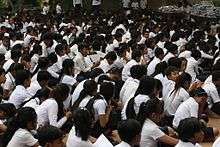
In Cambodia, students of all ages (pre-school to college) wear school uniforms.[10] The uniforms differ by school and age level. Generally, boys wear a white dress shirt and a pair of shorts. The color and length of the shorts varies at each school. Male college students wear the same kind of uniform, but instead of shorts, they wear black dress trousers. Girls usually wear white blouses and a skirt. Their skirts vary in color and length depending upon the school and their ages. Generally, the younger students wear long skirts that almost reach their ankles and older students, particularly in college, wear shorter ones. Skirts are generally blue or black but may be other colors as well, depending on the school. Some schools also have alternative uniforms which students of both genders wear every other day. These often consist of a colored shirt and slacks. High school girls must wear black or blue long skirts. High school boys wear long black or blue trousers. The white shirt can be short-sleeved or long-sleeved for both genders. High school students are also required to wear name tags on the left hand side of their shirts.
Canada
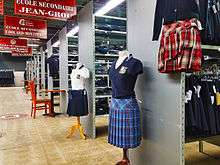
In Canada, the province of Quebec is the only province where school uniforms are present in a majority of schools. Within the English school system of Quebec, almost all schools from elementary to high school have mandatory school uniforms. In the rest of Canada, school uniforms are not required in most public schools or separate schools, except in exceptional circumstances such as school performances or international field trips. However, the majority of Catholic high schools in southern Ontario (Grade 9-12) do require uniforms.[11] These uniforms generally have long- or short-sleeved shirts with the school logo or crest near the collar and trousers or kilted skirts. Schools often allow girls the option of choosing to wear a skirt or trousers. Some schools also mandate dress shoes and a particular type and length of socks to go with the uniform. A cardigan sweater, vest, or blazer may be part of the ensemble, particularly in winter. Additionally, as of 2011, the Toronto Catholic District School Board has implemented an Appropriate Dress Code of navy blue and white in all elementary separate schools which do not already have their own uniforms.[12]
Otherwise, specific regulations and policies regarding school-appropriate dress and the extent of dress code enforcement will vary by school.
Uniforms are used in most private schools, and also in special or alternative programs of public and Catholic schools, such as the Traditional Learning Centers, a program that takes a liberal arts approach, while focusing on high levels of academic excellence. In Quebec, most metropolitan anglophone school boards require a uniform.
Chile
In Chile, most schools have a uniform.
Until 1930, it was uncommon for students to wear a uniform. Under the government of Carlos Ibáñez del Campo, all students became obliged to wear a school uniform. During the administration of Eduardo Frei Montalva, a unified uniform was introduced for all public and private schools and other education centers. Today, these uniforms have disappeared in private schools, who prefer to use a customised one.
China

Uniforms are a common part of the schools in China. Almost all secondary schools as well as some elementary schools require students to wear uniforms. Uniforms in mainland China usually consist of five sets: 2 formal sets and 3 everyday sets. A formal set is worn on Mondays or special occasions (school anniversaries, school ceremonies, etc.) They consist of a white collared shirt with a sweater on top and a skirt for girls or a suit for boys. There is one formal set for summer and one set for winter. Everyday uniforms for boys in the winter usually consist of a zippered sweater and trousers and a collared shirt (usually white). Thinner materials are worn in the spring and fall and short or long trousers may be worn in the summer. The everyday uniforms for girls are very similar to the boys' uniform. It is relatively common for there to be some kind of sponsored advertisement on some non-formal school uniform shirts, though this trend has fluctuated in recent years.
Colombia

In Colombia, all students are required to wear uniforms in public and private schools. Uniforms in Colombia consist of two sets, one for everyday use and a sports one for physical education. Everyday uniforms for girls generally include a knee-length skirt, a white T-shirt with a vest, and white calf-length socks. For boys, the uniform generally includes dark-colored long trousers and a short- or long-sleeved shirt. The shoes for both girls and boys are black lace-up shoes (sometimes the shoes may be dark blue or wine-colored, depending on the uniform colors) and the shirts usually have the school's symbol at the left side. The sports uniform includes sweat pants, a collared T-shirt, and white sports shoes. The designs and the colors of the uniforms depend on the school's colors and the principal's preference.
El Salvador
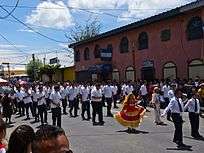
In El Salvador, all students from public schools and private schools are required to wear uniforms.
France
Since 1968, uniforms have not been enforced in French schools, a few exceptions (such as Maison d'éducation de la Légion d'honneur, les Écoles TUNON, and Vatel). Xavier Darcos, a former teacher and Minister of Education from 2007 to 2009, is an advocate of the reintroduction of uniforms: "This is not outrageous. This removes the visible differences in social status or wealth. This is an additional factor of integration".[13]
Since March 2012, the students of the Boarding School of Excellence Sourdun wear a uniform with the insignia of their establishment.
Les lycées de la défense, formerly known as military schools, require their students to wear uniforms. At some universities, the academic dress is becoming popular.
In the French Antilles (Martinique and Guadeloupe), as well as French Guiana, a uniform has been required since September 2008.
Germany

There is no tradition of wearing school uniforms in Germany, and today, almost all students of state schools, private schools or universities do not wear school uniforms. However, certain garments have been common to students in former times:
From the 16th century, students (especially of secondary or grammar schools and similar institutions) were often subject to regulations that prescribed, for example, modest and not too stylish attire. In many cases these regulations were part of wider laws concerning the clothing of all citizens of certain social classes.
A blue coat became a widespread obligatory status symbol of students of secondary schools; it fell out of use during the latter half of the 18th century. In more recent times, school uniforms in any real sense did not exist outside of convent schools and private boarding schools. At times, certain fashions became so widespread that they approached uniform status; this is true in particular for so-called student hats (Schülermützen) that became widespread from the 1880s on and remained somewhat popular until they were banned by the Nazis. Their wearing was advocated by teachers and the students themselves and occasionally made mandatory, but never on a national or statewide level. Another instance are the sailor suits that became fashionable around the turn of the 19th century. These, too, were not usually a prescribed uniform.[14]
The Nazis banned student hats – the last remaining, if voluntary, form of unified student clothing – because they considered them an attribute of class society. They did, however, institute mandatory membership in the uniformed Hitler Youth (HJ) from 1936 until their fall. HJ uniforms were worn in the HJ training academies and in the Napolas; students of other schools sometimes wore them to school at their own discretion.
In recent times, the introduction of school uniforms has been discussed, but usually the expression "uniform" (the word is the same in German) is avoided in favor of terms like "school clothing" ("Schulkleidung"). School clothing has been introduced in a small number of schools, for example in Hamburg-Sinstorf in 2000, and in Friesenheim and Haag (Oberbayern) in 2005. In these cases the clothes are collections of shirts, sweaters, and the like, catering to contemporary fashion senses. Uniforms in a more traditional sense are almost never proposed in earnest.
The debate on mandatory school uniforms intensified in Germany when two Muslim girls dressed in burkas arrived at a school in Bonn in 2006. The girls' actions were interpreted as political action and they were subsequently suspended from school. Then-Justice Minister Brigitte Zypries in an interview with the Welt am Sonntag stated that the simple solution to the issue under consideration is mandatory introduction of school uniforms for boys and girls across Germany. She further argued that school uniforms would help to prevent conflicts arising from religious or political differences. Her stance was supported by then-Minister Of Education Annette Schavan. The proposal was met with opposition from the teacher union and opposition political parties. The teacher union argued that school uniforms are not the solution for integration problems nor the issue of fashion obsession. The leader of the teacher union Heinz-Peter Meidinger also added that the school uniforms have been a controversial issue in Germany over the years.[15]
Opposition to school uniforms
A senior member of the Green Party, Krista Sager, also said that the introduction of school uniforms would be unacceptable state interference in religious matters. She then proposed that individual schools have to find their own solutions and rejected solutions imposed by government. She further noted that school uniforms are no longer up to date and their imposition would be rejected by the current generation of students. The Conference of Education Ministers, a body which decides on school policies, also kicked back against school uniforms. They cited historical reasons dating back to WWII with memories of Hitler Youth's uniform still fresh in people's minds. They also concluded that the imposition of school uniforms would be excessive government encroachment on personal liberty of pupils and parents.[16] However, a number of schools sell branded clothing that can be worn as a sign of school pride.[16]
The Bildungsstreik movement fights against school uniforms due to their belief that it represents some kind of militarism.[15]
Ghana

All children have to wear school uniforms in Ghana. Pupils in public schools have the same type of school uniform with the school's emblem imprinted on the left chest. This helps to distinguish pupils of one school from the other. Private schools determine which uniforms their pupils wear.[17][18][19] On April 11 2019, the Director-General of the Ghana Education Service, Prof Kwasi Opoku Amankwa announced at a press conference in Accra that public Junior High School pupils will start wearing a new uniform beginning from the 2019-2020 academic year. [20] The new uniform is primarily to distinguish the Junior High pupils from their peers at the primary level. The current brown and yellow khaki school uniform, locally referred to as Konkonte and nkate nkwan (groundnut soup) and worn by pupils at the basic level in public schools, was introduced over 30 years ago by the government.[21]
Hong Kong

The vast majority of schools in the former British colony adopted uniforms similar to that of British schools, while Catholic schools in Hong Kong usually follow the tradition of Catholic school uniforms.
A number of older Christian girls' schools established around the midpoint of the 20th century, however, retain the heritage of using the Chinese cheongsam as their uniform, such as St. Stephen's Girls' College, True Light Middle School, Ying Wa Girls' School, and Heep Yunn School.[22] Sailor suits are also used as uniforms in some kindergartens for boys and girls, and secondary schools but for girls only, for example the Bishop Hall Jubilee School and New Method College.
St Paul's Girls' College, now St Paul's Co-educational College, introduced a cheongsam as its uniform in 1918, making it Hong Kong's first school uniform.[23] True Light Girls' College was the first Hong Kong secondary school to have a cheongsam uniform.[22]
While Hong Kong campuses of British public schools use hats for reasons of tradition, most Hong Kong schools have no hats in their uniforms.[24]
India
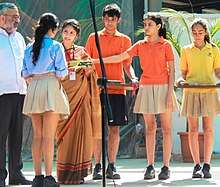
Uniforms are compulsory in India in both public and private schools. The boys' uniforms are often made of a light-colored shirt, long trousers usually blue, white or black, and those of the girls are often a shirt and a skirt. At the state level, the secondary schools are required to use a salwar kameez. This is not compulsory but they do have certain specific dress code.
Many schools require students to wear uniform shoes, ties and ID cards, and comb their hair down and keep it clean and short. Long hair is tied in braids. Uniform is one of the most important components of school life and is taken very seriously in India.
Some institutions also require the use of a tie, especially the schools run by Christian missionaries, and the Indian government does not prohibit the children to have religious symbols, so the Muslim girls can wear the veil (hijab) (burka) and Sikh boys a turban in addition to the uniform. However, most of the schools, whether public or private, prohibit students to have a ponytail or dyed hair.
Indonesia
In Indonesia, school uniforms are mandatory for every student. They can be simply described as below for each stage of education:
- Primary schools or Sekolah Dasar (SD) students wear a white short-sleeve shirt with red shorts for male students, and below-knee skirts for females.
- Lower secondary schools or Sekolah Menengah Pertama (SMP) require navy blue shorts or trousers with a short-sleeve white shirt for male students. Females wear a below-knee-length or long navy blue skirt and short-sleeve white shirt.
- Upper secondary schools Sekolah Menengah Atas (SMA) require blue-grey trousers with a short-sleeve white shirt. Females wear a below-knee-length or long blue-grey skirt, and wear short-sleeve or long-sleeve white shirts.[25]
Public schools in Indonesia tolerate religious freedoms. For example, Muslim girls may opt to wear long-sleeve shirts, longer skirts, and jilbab to cover their heads. Most schools in Indonesia also have a batik uniform, usually worn on Thursday or Friday. This kind of uniform consists of a batik short-sleeve or long-sleeve shirt, with long or short trousers for SMA and below-knee or long skirts for females. The motifs and colors of batik depend on the school. Some schools tend to issue neckties and/or vests for their students. These neckties and vests may vary from school to school in color and sewing pattern, even among public schools.
Nowadays, with the increase of private schools in Indonesia, most private schools have their own signature school uniform. Most consist of shirts with shorts or trousers for males, and skirts for females, only with differences on the color.
Every school has its own standard grooming. Males are not allowed to have long hair. Accessories are also normally prohibited for males, except for watches. Females are usually allowed to use simple accessories such as watches, earrings, and sometimes bracelets. Wearing nail polish is usually not allowed.
Most schools pay attention to the shoes that can be worn. Black or white sneakers with white laces are the most common shoes. Few higher-level students, such as in SMA or SMK, are normally required to wear black leather shoes.

The school badge is usually put on the right sleeve of a shirt, consist of school's name and location, and some have their own school's logo. Others prefer to wear the school's logo as a lapel or breast plastic or metal pin. The emblem of OSIS (Organisasi Siswa Intra Sekolah), or School's Intern Student Organization, is put on the shirt's left pocket. Students' names are usually on the right side of the shirt and embedded by sewing, ironing or as a detachable badge. Some schools (usually "SMP" and "SMA") distinguish the grade of their students by stripes on the official neckties issued or an emblem below the school emblem (it can be stripes, chevrons or numbers). Nowadays some schools require the students to wear an Indonesian flag school badge sewn on top of their left pocket.
The scouts (pramuka) uniform is used in many schools in Indonesia at least once a week. It consists of light-brown short-sleeve or long-sleeve shirts, with dark-brown shorts or trousers, and below-knee skirts or longer for females. The common day to wear the scout uniform usually falls on Wednesday, Friday, or Saturday. Furthermore, on certain occasions (usually on ceremonies or competitions), the uniform should be worn as full dress, with red and white scarf/necktie, dark brown beret, rope, dagger and scout's stick.
The scout uniform has two breast pockets. Above right pocket is the student's name. The Gerakan Pramuka Indonesia (Indonesian Scout Movement) logo is sewn on the left pocket (for male students). On the right sleeve there are scouting organization's location, number and logo, while on the left sleeve usually are the student's scouting team logo and chevrons denoting his/her grade. Male students wear International Scout Organization logo above their name and female students on their lapel.
Israel
According to former Education Minister Limor Livnat, about 1,400 Israeli public schools require pupils to wear uniforms.[26]
School uniforms used to be the norm in the state's early days, but have since fallen out of favor. However, in recent years, the number of schools using school uniforms has been increasing once more. Many teachers, parents and students are in favor of returning the school uniform to common use to prevent the deepening of the gap between affluent children and those less well-off. Nowadays school uniforms are mainly associated with "national religious" schools within the Israeli system of education.[27] Schools for Arab citizens of Israel also frequently require uniforms: for girls, it is often a pinafore to be worn over trousers and shirt.
In the Haredi or ultra-Orthodox school system, uniforms are compulsory in essentially all girls' schools. In the vast majority of these, the style adopted by the Beit Ya'akov network is used: a sky-blue, button-down, open-collar, loose-fitting blouse with an Oxford-blue, pleated skirt which comes to just below the knee and dark stockings. In cold weather, a Yale-blue sweater may be added. A small fraction of schools alter the color scheme to pink and burgundy, while otherwise retaining the same overall appearance. In boys' schools there is usually not an identifiable school uniform, distinct from what is considered acceptable for ordinary street wear. However, the standards of acceptable street wear for boys and men in Haredi communities are so precise and exacting that in almost all cases all of the boys in a particular school will be dressed identically.
In non-Haredi schools today, school uniforms in Israel consist only of a shirt with the school logo. In the summer, the uniform shirt is a simple T-shirt, while in the winter, the shirts worn are warm or hooded sweaters. Although the shirts are uniform, they usually come in various colors, and allow students to customize and express themselves even while wearing a uniform. The shirts sell for a very small amount of money, so that even the less well-off can acquire them.
Italy
In Italy, school uniforms are uncommon, partially because child uniforms are associated with the era of Benito Mussolini before World War II when children were placed according to their age into Italian Fascist youth movements and had to wear uniforms inside and outside school.
However, until the early 1960s many high schools required girls to wear black grembiule (resembling a doctor smock) on top of their clothes: no uniform was required for boys.
Nowadays, many pre-schools advise parents to dress their children with a grembiulino, i.e., a small grembiule, usually shorter and more colourful, that can be purchased cheaply.
Some elementary schools advise some kind of grembiule for the younger pupils. Sometimes girls are required to wear a pink or white grembiulino, while boys may be required to wear a short cotton jacket, usually blue or black. In other cases both boys and girls may be required to wear a more neutral blue grembiule.
Some parents send their children to school in a grembiule even if the school does not require it.
Poet and children's writer Gianni Rodari has described adult life as "a school without grembiule and school desk".[28]
In 2004 the Italian chapter of WWF warned that synthetic grembiuli were harmful to pupils.[29]
In July 2008 Education Minister Mariastella Gelmini proposed the re-introduction of the compulsory smock in public schools, provoking a debate in the Italian press.[30]
Japan
.jpg)
Japan introduced school uniforms in the late 19th century. Today, school uniforms are almost universal in the public and private school systems. They are also used in some women's colleges. The Japanese word for uniform is seifuku (制服).
In the majority of elementary schools, students are not required to wear a uniform to school. Where they are required, many boys wear white shirts, short trousers, and caps. Young boys often dress more formally in their class pictures than they do other days of the school year. Girls' uniforms might include a grey pleated skirt and white blouse. Occasionally the sailor outfit is used for girls. The uniform codes may vary by season to work with the environment and occasion. It is common for boys and girls to wear brightly coloured caps to prevent traffic accidents. It is normal for uniforms to be worn outside of school areas. However, this is going out of fashion and many students are wearing casual dress.
The Japanese junior- and senior-high-school uniform traditionally consists of a military style for boys and a sailor outfit for girls. These uniforms are based on Meiji era formal military dress, themselves modeled on European-style naval uniforms. The sailor outfit replace the undivided hakama (andon bakama 行灯袴) designed by Utako Shimoda between 1920 and 1930.[31] While this style is still in use, many schools have moved to more Western-pattern parochial school uniform styles. They consist of a white shirt, tie, blazer or sweater vest with school crest, and tailored trousers (often not of the same colour as the blazer or sweater vest) for boys and a white blouse, tie, blazer with school crest, and tartan skirt for girls.
Much like the male uniform, the gakuran, the sailor outfit bears a similarity to military-styled naval uniforms. The uniform generally consists of a blouse attached with a sailor-style collar and a pleated skirt. There are seasonal variations for summer and winter: sleeve length and fabric are adjusted accordingly. A ribbon is tied in the front and laced through a loop attached to the blouse. Several variations on the ribbon include neckties, bolo ties, neckerchiefs, and bows. Common colours are navy blue, white, grey, light green and black.
Shoes, socks, and other accessories are sometimes included as part of the uniform. The socks are typically navy or white. The shoes are typically brown or black penny loafers. Although not part of the prescribed uniform, alternate forms of legwear (such as loose socks, knee-length stockings, or similar) are commonly matched by more fashionable girls with their sailor outfits.
Regardless of what type of uniform any particular school assigns its students, all schools have a summer version (usually consisting of a white dress shirt and dark slacks for boys and a reduced-weight traditional uniform or blouse and tartan skirt with tie for girls) and a sports-activity uniform (a polyester track suit for year-round use and a T-shirt and shorts for summer activities). Depending on the discipline level of their school, students may wear seasonal and activity uniforms in the same classroom during the day. Students may attempt to subvert the system of uniforms by wearing them incorrectly or by adding prohibited elements such as large loose socks or badges.
Miniskirts have been very popular in Japan, where they became part of school uniforms, and they came to be worn within the Kogal culture.[32][33]
Lebanon
In Lebanon, all private schools require uniforms. Most of the uniforms are made of a skirt, a shirt, and a pull-over for girls, and for boys it's made of trousers, a shirt, and a pull-over. Some public schools there do not require school uniforms.
Lesotho
In Lesotho school uniforms are still compulsory.[34] Many poor families can not afford them, which is one of the reasons for the high dropout rate in primary schools.[35]
Malaysia
In Malaysia, school uniforms (Malay: Pakaian Seragam Sekolah) are compulsory for all students who attend public schools. Western-style school uniforms were introduced to present-day Malaysia in the late 19th century during the British colonial era. The present design was standardised beginning in January 1970. Today, school uniforms are almost universal in the public and private school systems.
The uniforms at Malaysian public schools are as follows:[36]

Students are required to wear white socks and white shoes with the above uniform. For modesty reasons, most schools require female students who wear the baju kurung to wear a plain-coloured camisole underneath.[37][38][39][40]
In addition to these, schools usually have badges which must be sewn or ironed on to the uniform — generally at the left chest. Some schools require students to sew their name tags in addition to the badge. For upper forms, students generally have to wear a school-specific tie, except those who are wearing the baju kurung.
In Malaysia, Muslim girls tend to wear the baju kurung. Most of them start wearing a white tudung (Malaysian version of the Muslim headscarf or hijab) upon entering secondary school, for religious reasons. Non-Muslim girls tend to wear the pinafore. Some non-Muslim girls wear the baju kurung.
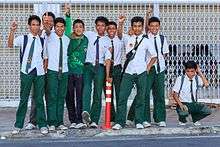
Muslim boys may wear baju melayu at school on Fridays, often with a songkok hat, to be dressed for going to the mosque for prayers at lunchtime.
Girls who choose to wear the pinafore, especially those attending co-ed schools, usually wear shorts under their pinafore to allow for carefree movement as the skirt only covers up to the knee. Those who wear the baju kurung tend not to wear shorts under their long skirt as their skirt covers their legs.
Neckties are often worn by prefects, class monitors, librarians, and other students of rank. Some schools have neckties as standard issue; even then, the neckties are generally reserved for school events and public appearances, and are not part of the everyday school uniform. The tropical climate makes them uncomfortable.
The hairstyle of students is given attention by schools and the Ministry of Education.[41] Schools do not allow students to colour their hair. For boys, there is usually a maximum length allowed, for example, the hair must be a few centimetres above the collar, and no sideburns are allowed. Violation of boys' hair regulations is often punished with a caning; some offer the alternative of an enforced haircut at the school.[42] The use of hair gel is prohibited in some of the stricter schools, to prevent excessive hairdressing. Girls' long hair must be properly tied up, often into a ponytail. Some schools dictate the colour and type of hair accessories that can be used. Some prohibit even girls from having long hair. Wearing make up in school is prohibited.
Schools usually enforce their uniform code thoroughly, with regular checks by teachers and prefects. Students who fail to comply may be warned, given demerit points, publicly punished, sent home from school, or caned.[43]
Mauritius
School uniforms in Mauritius are generally compulsory. Mauritius being a former British colony, has been using the system from back then. The students have to wear uniforms from primary school until higher secondary level. However, there are a few private schools that are based on the French system and do not require the student to wear school uniform.
Mexico

In Mexico, students from all public primary and secondary schools, and some public high schools are required to wear uniform (except on special days and/or occasions like holidays in which the school allows students to wear normal clothing rather than the uniform).
Most private schools require uniform even since nursery school, however, many private secondary and high schools are opting to eliminate it.
Mexican uniforms have the school's logo and colours. Most Mexican schools have 2 types of uniforms: one for P.E. and another for regular school days. Many public secondary schools have a different regular uniform for each grade, especially for girls.
Uniforms usually consist of the following (but may vary by school):
- Regular
- Boys
- Polo shirt
- Vest or sweater
- Cloth pants
- Socks
- Black shoes
- Polo shirt
- Girls
- Polo shirt
- Vest or sweater
- Pleated skirt (plaid most of the time)
- Knee high socks (white for most public schools)
- Black mary janes (elementary school) / black laced shoes (secondary school)
- Boys
- P.E.
Note: The uniform is unisex most of the time.
- Polo or shirt
- Open sweatshirt
- Athletic pants
- socks and sneakers (preferably white)
Nowadays, a complete school uniform set cost can go up to 98.39USD for girls, and 102.32USD for boys, which contradicts the uniforms implementation original goal during the 1930s: to reduce clothing costs and avoid classism.[44]
On 2019, Mexico City's government announced a new Law that permitted pupils to choose whether to wear the pants or skirt version of their regular uniform, regardless of their gender. If successful, this new practice might be implemented in other states of the republic.[45]
Nepal
School Uniforms are compulsory in Nepal in both public and private schools. The boys' uniforms are made of shirt with long or short sleeves, long trousers with various colours set by their school and girls uniforms with similar colours are often a shirt and a skirt.
Many schools require students to wear shoes, ties and ID cards, and schools has strict policies with hair styles and required to comb their hair down and keep it clean and short. Long hair is tied in braids. Uniform is one of the most important components of school life and is taken very seriously in Nepal.
New Zealand
Traditionally, many New Zealand intermediate and high schools, and state-integrated and private primary schools, have followed the British system of school uniforms,[46] although it is common in state schools for the boy's uniform to have a jersey and grey short trousers rather than a blazer with tie and long trousers. This usually consists of a variety of the following apparel: for boys, a business-style shirt with an official school tie, and long or short trousers; and for girls, a blouse, and a plain and/or plaid (usually tartan) skirt, and in some schools, especially in the South Island, kilts. Both sexes wear an 'official' school jersey. Blazers and jackets are of varied colours according to the school - dark or light blue, grey, crimson, scarlet, green or black. Some follow the British practice of having contrasting colours edging the lapels and jacket fronts. Caps have generally been discarded since the 1970s but in many primary schools there is a compulsory broad-brimmed floppy hat, in the school colours, to help prevent sunburn. Where short trousers are worn, boys are usually required to wear long dark socks, which may require garters to hold them up.[47] Since 1990 an increasing number of schools, especially in the North Island, include sandals as the standard summer footwear. Many schools also allow students to attend barefoot, with a relatively large number of students choosing to do so.
During the 1980s and 1990s there was a tendency for the traditional uniform to be replaced by cheaper and more 'modern' options: polo shirts,[48] polar fleece tops, or a complete doing away with uniforms in favour of mufti. Intermediate schools usually provide the option of skirts or culottes for girls and sometimes shorts while boys will wear shorts. Bike shorts or tights are sometimes worn under girls' skirts and dresses. Some high schools have introduced trousers as an option for girls instead of skirts, however demand is low with several Christchurch high schools estimating only 1% of girls at their respective schools wear trousers.[49]
Nigeria
School uniforms are used in Nigeria for all public and private schools right from the nursery school to the primary and secondary schools. This originally came with the introduction of western education by the Christian missionaries and the act continued during the colonial era up till the current era of independence.
North Korea
All North Korean students in schools are required to wear uniforms. Makeup is prohibited until graduation from high school.[50] Dress codes in universities vary with some requiring uniforms and others requiring formal wear.
Pakistan
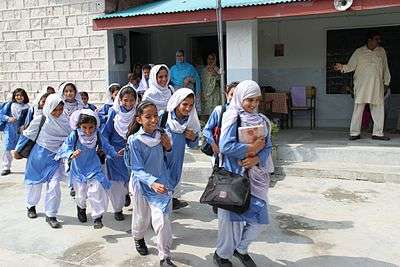
The school uniforms are compulsory in most schools in Pakistan. Both the public and the private schools have mandated uniforms. Boys uniforms are often made of a light-coloured shirt, long trousers usually brown or blue. The girls often wear Shalwar Qameez suit or in some schools shirt and skirt.
Peru
School uniforms are used in Peru. Almost all private schools, especially, the British one's use schools uniforms.
Philippines
School uniforms (Filipino: uniporme or kasuotang pampaaralan, "school attire"), much like Mexico, are commonplace in public schools and required in private schools. In some private schools, there are specified days when students can wear civilian clothing, typically in special occasions like a holiday or last day of school. There is usually no uniform in universities and progressive schools except for uniforms used in P.E classes, and in specific schools such as the University of Santo Tomas.
Public school uniforms for primary levels are typically white, short-sleeved, buttoned-up shirts, with long skirts for girls and light brown knee-length trousers for boys. Uniforms for public high schools and private schools vary widely in pattern and colour, but most often are in the official school colours. Muslim girls in some higher institutions are often required to wear a white hijab versus other colours. Some school uniforms in the Philippines can bear resemblance to Japanese school uniforms.
The material for these usually loose uniforms is often light and suited to the country's tropical climate (e.g. cotton).
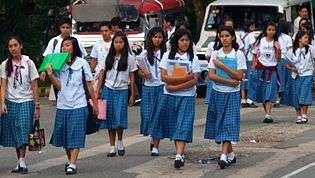
- Primary school
- Boys
- White polo shirt and
- Navy blue short trousers and Navy blue trousers; or
- Navy blue long trousers
- Blazer or vest (in some international schools)
- Necktie (some schools)
- White polo shirt and
- Girls
- Cream-coloured blouse and checkered skirt; or
- Sailor uniform with knee-length checkered or plaid blue skirt
- Blazer or vest (in some international schools)
- Necktie (some schools)
- Boys
- White Polo and
- Brown Slacks; or
- White Polo with black trousers; or
- White trousers (generally only for prefects)
- (May include a blazer for certain international schools)
- White Polo and
- Girls
- White or yellow blouse (with necktie) and checkered deep green skirt; or
- Sailor uniform with knee-length checkered blue skirt
- (May include a blazer for certain international schools)
- Boys
In 2008, the Department of Education ordered that students are no longer required to wear uniforms. This was to allow poorer families to save money for basic needs.[51][52]
Poland
School uniforms are not compulsory in Poland and absent from the vast majority of Polish schools. The idea of school uniforms in Poland did not exist before the early 20th century. In the People's Republic of Poland, uniform ceased to be compulsory in most schools during the 1980s due to economic issues. Since then, there has been made only one effort to reintroduce uniform into Polish schools - by the former minister of education Roman Giertych, in 2006. It was then decided that school uniform would not be enforced by the state onto the whole country, but would be a matter decided upon by the principal of each school respectively. Initially this was meant to permit only a dress code, but this was later modified in 2007 to address school uniform. From 2007, all primary schools and middle schools were to enforce compulsory uniform, whilst high schools and other forms of further education were given the choice to decide on their own. The appearance of school uniform was decided upon locally, which meant that "uniform" in most schools consisted of a jacket or shirt only - selected by the school management purely to avoid breaking regulations (the rest of clothing was still up to the students to decide). By mid-2008, compulsory school uniforms were repealed and it remains so to this day.
Ireland
In Ireland, almost all primary and secondary schools require students to wear a uniform. These can vary from school to school but for the most part include trousers for male students, a skirt or pinafore for female students and a shirt, a jumper and a necktie. In recent years many schools also offer the option of trousers for female students. Some schools require blazers rather than jumpers. Some primary schools now let their pupils wear a school tracksuit rather than a formal uniform.
In recent years there has been criticism, including by the Department of Education of the requirement that a school uniform jumper must have the school crest or name imprinted onto it and of the practice where a school's uniform can only be bought from a certain supplier, which can markedly increase the price of a uniform. As well as rules regarding the wearing of a uniform many schools have regulations regarding hair, footwear, the growth of facial hair for males, the wearing of makeup and the length of school skirts.[53]
Russia
During the Soviet period, a standardised "universal" school uniform was worn by all schools. Originally of a military style with peaked cap and high collared tunic, by the 1980s boys wore a functional dark blue pattern with shoulder patches identifying the school. For formal occasions such as the first day of term, girls wore white lace collars and aprons dating back to the reign of Catherine the Great. During the initial post Soviet period from 1994 to 2013, the mandatory uniform policy was abandoned and pupils generally wore casual clothing such as jeans, T-shirts and sweaters. However, uniforms were reintroduced under a new education law in September 2013.[54] Among the supporters of the new uniform law of 2013, arguments included tackling social inequality, but also putting an end to the controversial problem of whether school students are allowed to wear traditional religious clothing to school.[55]
Each school can now choose its own uniform.[54] Also, there are many instances in which schools do not enforce the rules on school uniform. Generally, schools without school uniforms enforce dress-code, with "business-casual" style of clothes.
South Africa
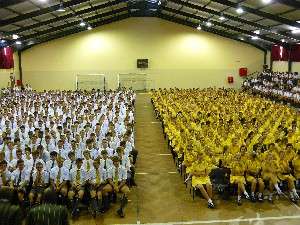
As in many other former British colonies, all South African private and public schools have a uniform, and it is compulsory in all public schools and in the vast majority of private schools for children above pre-school level.[56] Uniform types vary less between public and private schools than they do across regions, where schools in more rural areas tend to forgo the daily wearing of ties and/or blazers for boys and girls regardless of their public or private nature. However, many of these same schools will have a "number ones" uniform for special occasions which include such items. In cities such as Cape Town, on the other hand, it is more common to see formal apparel required in public and private schools on a daily basis.
Many schools across South Africa also provide the choice between a summer and winter uniform, with khaki uniforms and brown shoes being very common in the summer. Although many schools allow girls to also wear trousers (especially during winter months) South African law has not required gender neutrality in school dress codes and a distinction between girls' and boys' uniforms remains. Boys of all ages are normally required to wear grey or khaki long or short trousers with socks, and the socks are usually long when worn with shorts, as in the illustration (right). Until recently, the straw boater was a common accessory in affluent public and private high schools, although these have now become optional in some cases.[57]
Nearly all schools, public or fee paying, have sports' kits (uniforms) that often allow bare feet for junior schools, regardless of the season.
South Korea

Almost all South Korean secondary students wear a uniform called "gyobok" (Korean: 교복, 校服). The majority of elementary schools, except some private ones, do not have uniforms; however, the uniform is strictly monitored from the start of middle school and up. Based on Western-style ones, the South Korean uniform usually consists of a shirt, blazer and tie, with skirts for girls and trousers for boys.
More recently, the uniform is often worn by celebrities who target the younger, teen audience to sell entertainment products. The school uniform and school setting is frequently used as a venue for romance. As a result, the uniform has become something akin to an expression of fashion among students.
Name tags that are worn usually have different colours per grade. Oftentimes the writing is in black or white, whereas the background is coloured.
Spain
In Spain the use of school uniforms is not compulsory in the public school at any stage. Their use depends on school councils involving parents. However, it is customary to wear uniforms in private schools, where typically girls wear uniform shirt and jersey skirt and boys wear white shirt and tie and sometimes jacket.
Sri Lanka
It is mandatory for Sri Lankan school students to wear a uniform regardless of them attending a government, semi-government or private school. In most government and semi-government schools, boys will wear a short-sleeved white shirt and a navy blue short when they are in the junior grades. This will later transition to white shorts and then to white trousers towards the latter part of the school life. A tie is not always worn, but may be worn for special school events along with a long-sleeved shirt. Proper black dress shoes and socks are also a part of this uniform. Certain schools also require the uniform to have the school's insignia stitched to a corner of the pocket of the shirt.
Girls who attend government and semi-government schools will wear a white one-piece dress. This may or may not have sleeves. Certain schools make wearing a tie mandatory for girls and some may have a plastic badge or the school's insignia stitched to the dress. Proper dress shoes and socks are mandatory in most schools.
On special occasions, students who bear a post in a sports team, club or association, would wear a blazer which would normally be white and having accents based on the school colours.
In privately run schools, the suit is very similar but the colours might differ. They range from khaki and dark green to bright blue.
Taiwan
.jpg)
As Taiwan experienced a long period of Japanese colonial rule, it is influenced by Japanese culture and the uniform style can be said to be close. However the school uniforms in the two regions are not identical.
There are a total of 471 Taiwanese high schools. All schools have two sets of uniforms, a summer uniform and a uniform for winter. According to the provisions, sportswear is worn.
Summer
Elementary school (Chinese: 國小):White short pants and shirts are most common for the boys, while girls will wear a pleated skirt
Junior high school (Chinese: 國中):Males wear short-sleeved shirts with shorts. Females wear shirts with pleated skirts or skirt pants. Some schools have sailor uniforms.
Senior high school (Chinese: 高中):Short sleeved shirts with long pants for males, pleated skirts or shorts for females in public schools; private schools will always have skirts
Winter
Long pants and long sleeved shirts are worn in most schools.
In the past, many schools had khaki uniforms but this has been phased out with the exception of a few schools.
See also: Uniform Map.
Thailand
-

Uniforms are compulsory for all students with very few variations from the standard model throughout the public and private school systems, including colleges and universities.
The dress code in primary and secondary grades for boys comprises dark blue, khaki, or black shorts with a white open-collar short-sleeved shirt, white ankle socks or long dark socks, and brown or black trainers. Female students, wear a knee-length dark blue or black skirt, and a pale white blouse with a loosely hanging bow tie. The bow tie is dropped in favour of an open-necked pale blue shirt from Matthayom 4.
The girls' uniform is complemented by white ankle socks and black school shoes. The student's name, number, and name of the school are often embroidered on the blouse or shirt. Some independent or international schools have uniforms more closely resembling British school uniform standards, and boys in senior high school grades may be allowed to wear long trousers. The standard dress for children in kindergarten is a red skirt and white blouse for girls, and red short trousers and a white shirt for boys. In all Thai schools, one day per week, usually Wednesday, is dedicated to scouting, when beige scout uniforms for boys and dark green guide uniforms are the rule, both wearing yellow neckerchiefs.
The hairstyle of students is also given attention by schools and the Ministry of Education. Males are not allowed to have long hair. Some prohibit even girls from having long hair.[58][59] The use of accessories is prohibited for males, while females are sometimes allowed to use simple accessories. Some schools dictate the colour and type of hair accessories that females can use.
Thailand however has a few international schools which do not require uniforms.
Tonga

In Tonga all schools require a uniform. Uniforms are usually in the colours of their respective churches and Red for Government Schools. Catholic schools are usually light blue, Wesleyan (Royal Blue), Anglican (Navy Blue) and LDS Schools (Green). A Ta'ovala bordered with school colours and a tupenu are usually worn by boys with a white button-up shirt. Pupils usually wear shorts and a white button up shirt. Nearly all Tongan secondary schools require girls to wear a pinafore dress with a white shirt, except for Catholic schools which allow a striped blouse and skirt. Pupils are usually required to wear Roman sandals in English-medium schools, and thongs (flip-flops) in most other schools.
Turkey

School uniforms were used in all public and private institutions. There were several exceptions and most kindergartens did not require school uniforms. The uniforms varied in their appearance; primary schools used one-piece blue uniforms, while in secondary and high schools boys wore dark grey trousers with white shirts, jackets and a tie. Girls had skirts and shirts coloured like the boys' uniform, plus a tie. Most private institutions have their own uniforms. School uniforms for primary schools were black until the 1990s. None of the universities or higher-education institutes have uniforms.
School uniforms abolished in 2012 and schools gave a poll to families to select uniform or casual cloths. Dress code says that students' shoulder should be covered, girls cannot wear leggings or miniskirts. This caused a controversy in Western cities since some students were wearing mini's, shorts and leggings. New law says that students can wear hijabs at school but it's prohibited to wear makeup, tattoos, piercings, dye ın hair etc.[60]
School uniforms have a long history in Turkey. They were first introduced because normal clothing would give hints about the child's family's economic situation. In order to prevent groupings amongst children from different social classes, uniforms were accepted.
However, school uniforms were officially abolished on 27 November 2012, when the Turkish Ministry of Education suddenly abolished the nationwide uniform requirement in schools (international/foreign schools are excluded) and lifted the headscarf ban for religious imam-hatip schools, prompting fierce criticism from opposition parties, unions and educators. Opponents claim that economic differences cause pedagogical traumas for children and that permitting headscarves harms secular education. Prime Minister Recep Tayyip Erdoğan defended the move, saying education in uniform has drawn complaints for many years. But students attending minority schools (Greeks, Jews and Armenians), which are also part of the Turkish Ministry of Education, have been excluded from this change, and are still required to wear school uniforms.[61]
United Arab Emirates
Uniforms are compulsory in many schools across the United Arab Emirates.
In June 2013, the Abu Dhabi Education Council standardised the uniforms for pupils in public school across Abu Dhabi. Earlier, each school had its own uniform. Uniforms include options for varying weather conditions. Boys in Kindergarten and Cycle 1 (Grades 1 to 5) can wear either a long-sleeved shirt and trousers or a short-sleeved shirt and shorts. Tie, winter blazer, and cardigan are optional. Boys in Cycle 2 and Cycle 3 (Grades 6 to 12) wear a kandoora (traditional white robe) and ghetra (head scarf). Pullover sweater or blazer are optional Girls in Kindergarten or Cycle 1 (Grades 1 to 5) wear a long sleeved shirt with either a school dress or skirt. Cardigan, blazer, and scarf are optional. Girls in Cycle 2 or 3 (Grades 6 to 12) wear a long sleeved shirt with a choice of a skirt or two different styles of dress plus a scarf. Cardigan or blazer are optional. These are only for the schools with the Arabic curriculum, not the other schools.
Private schools in the UAE require a school uniform. It can range from a T-shirt or a simple white/black polo bearing the school logo to a more complete uniform with a button up shirt worn with a skirt, shorts or trousers. In the British schools, there is a blouse and either a skirt or trousers for the girls or a button up shirt with trousers. Shirts bear the school logo. Certain schools have certain codes on the use of makeup (some don't condone it at all) and the sporting of bracelets/jewellery.
United Kingdom
While school uniform is common in the United Kingdom, there is no legislation enforcing it in any of the three separate legal jurisdictions of England & Wales, Scotland, and Northern Ireland, and enforcement of school uniform policy and dress codes is generally for individual schools to determine.[62] However, schools do have to take into account Equality legislation in dress policies to prevent discrimination on grounds such as age, sex, race, disability, religion or belief and sexual orientation.[63] School uniforms are required to be similar in cost for both boys and girls,[64] to be reasonably low cost, and to tolerate religious freedoms, e.g. allowing male Sikhs to wear turbans and female Muslims to wear headscarves.[65] In order to ensure that policies are fair and non-discriminatory schools are expected to consult widely with staff, pupils, parents and governors when introducing or amending dress policies.[66]
England
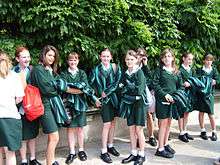
In 2011, more than 90% of English secondary schools had a compulsory uniform.[67] School uniforms were first introduced on a large scale during the reign of King Henry VIII.[68] The uniforms of the time were referred as "bluecoats", as they consisted of long trench-coat-style jackets dyed blue. Blue was the cheapest available dye and showed humility amongst all children. The first school to introduce this uniform was Christ's Hospital in London (now in Sussex).[69]
The Elementary Education Act 1870 introduced free primary education for all children. The popularity of uniforms increased, and eventually most schools had a uniform.[68] During this period most uniforms reflected the trends of the age, with boys wearing short trousers and blazers until roughly the age of puberty and then long trousers from about 14 or 15. Girls mainly wore blouses, tunic dress and pinafores.[68][70][71]
These uniforms continued until the 1950s when after the Butler reforms secondary education was made free and the school leaving age was raised to 15. These reforms encouraged schools to implement uniform codes which were similar to other schools. Distinct "summer" and "winter" uniforms were sometimes required, particularly for girls, for whom dresses were mandated for summer and gymslips for winter.[68]
In the 21st century, the typical primary school uniform is fairly casual while secondary school uniform is often formal. Uniform in primary school is generally a polo shirt or T-shirt, a jumper with the school logo, and trousers or shorts or a skirt. The typical secondary school uniform is a blazer, white shirt or blouse, a tie, trousers or skirt, and black shoes. Some primary schools have more formal uniform, with tie and blazer, and for secondary schools to require only a jumper. Uniforms sometimes match the school colours, but are most commonly found in blue, black and grey.
Scotland
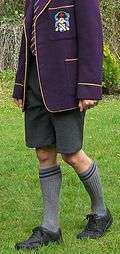
Scottish law is not specific on the question of school uniform. Generally, the school must provide information on its policy on clothing and uniform and the Education Authority must provide written information on its general policy on wearing school uniform. Some Education Authorities do not insist on students wearing a uniform as a precondition to attending and taking part in curricular activities.[72]
Children cannot be disciplined for not wearing a uniform if their parents do not want their child to wear it. However, a child that simply refuses to wear the school uniform can be disciplined by the school if it thinks that academic or disciplinary problems might be caused by the refusal. Many schools do have a policy covering the wearing of school clothing. The policy may state that certain items must be worn and that other items cannot be worn, for example, jeans. Schools must take religious and cultural requirements into account when drawing up a school uniform policy.[73]
Although the way that the uniforms are worn is usually not an issue, some state schools may have regulation on the subject (e.g. height of ties, whether the shirt is tucked in or not), the selection of clothes worn, whether they follow the policy, can be very strict. For example, in black and white uniform schools, wearing colours such as grey or wearing white shoes is forbidden. However, in schools that only use a basic uniform (e.g. jumper and trousers) the policy is often less strict.
Wales
The Welsh Assembly Government issued detailed guidance to governing bodies on uniform and appearance policies that begins by making explicit, "There is no education legislation specifically covering the wearing of school uniform or other aspects of appearance such as hair colour and style, and the wearing of jewellery and makeup. However, as part of its responsibility for the conduct of the school, a governing body can specify a uniform which pupils are required to wear and other rules relating to appearance."[74]
Northern Ireland
The Northern Ireland Executive supports poor families with the cost of paying for school uniforms with a £350 primary school uniform allowance. This is claimed via local Education and Library Boards for parents in receipt of income support. At the end of August 2009, there were 24,135 successful applications for the grant.[75]
The most common secondary school uniform in Northern Ireland is a shirt, blazer and sweater with a tie and a skirt or trousers. The uniform (most likely the sweater and tie) may change after Year 12. The uniform in primary school is similar to those used in the Republic of Ireland.
United States
Most schools in the United States do not require uniforms. Private schools and other specialized schools sometimes require an informal uniform, called a “standardized dress code”. Policy regarding school-appropriate dress, and the extent of enforcement, will vary by school and school district.
A study conducted in 2000 found that only 23% of public, private, and sectarian schools had any sort of uniform policy in the United States at or before 2000.[76] Over the subsequent decade, more public schools, specifically those in urban areas, instituted stricter dress codes. For instance, red, white or blue polo shirts, with a logo, with navy or khaki bottoms and a belt, was the uniform policy imposed at Palmer Elementary School in Houston, Texas.[77] Schools may also have polo shirts and trousers as a uniform. Roughly half the public schools in the United States had these more limiting dress codes by 2011.[78]
The schools that do require uniforms, or a more common standard dress code in towns and suburbs, tend to be more casual than those in Britain or other commonwealth nations. Commonly, students wear collared, buttoned shirts, with a tie for boys and a tie for girls, worn with khaki trousers, and a belt, depending on the age of the school's student body. Skirts of a modest length are occasionally an option for girls.
Dress codes vary widely among private schools, although a Catholic school uniform tends to keep the shirt and tie.[79]
Research studies and legislation
The National Association of Elementary School Principals (NAESP) conducted a phone survey of 755 principals in 2000, which revealed that 21% of public schools had a uniform policy; 23% had firm plans to create one.[80] However, this only accounts for those with school uniform policies and not for standardised dress codes, which provide for allowable student dress but are slightly more lax: For instance, instead of requiring everyone to wear the same shirt, or set of shirts, they may specify "any solid collared three-button polo/oxford shirt" and leave more specific details up to the parents. In 2007-2008, 55% of public school principals said their schools enforce a strict dress code, requiring students at least wear a collared shirt and trousers with an acceptable belt to school.[81]
Adolfo Santos, a political science professor at the University of Houston–Downtown, stated that many Hispanic communities in the United States choose uniforms because many immigrants originate from countries with schools requiring uniforms.[82]
Sylvan I. Alleyne, Velma LaPoint, Jennifer Lee and Harold W. Mitchell of The Journal of Negro Education stated that little empirical research exists regarding how effective school uniforms are in enhancing academic performance and social environments, and that little research exists regarding teachers' beliefs regarding issues related to dress codes, especially so regarding racial and ethnic minorities.[83] In the United States, literature regarding public school student clothing and behavior cites anecdotal viewpoints from teachers. The literature discussed opinions on faculty, staff, and other employees on how to deal with student dress issues.[84] A 2003 article of The Journal of Negro Education said that research and reports regarding the beneficial impact of school uniforms was not conclusive. Despite the federal government of the United States issuing a set of guidelines encouraging school uniforms in public schools, as of 2003 political support varied.[85]
In 1994, the Long Beach Unified School District, in Southern California, required school uniforms in all elementary and middle schools. This began a trend for uniforms in American elementary public schools, especially in urban school districts. President Clinton praised the idea in his 1996 State of the Union Address, saying that "if it means that teenagers will stop killing each other over designer jackets, then our public schools should be able to require their students to wear school uniforms." The adoption of school- or district-wide uniform policies (or "standardised dress codes", less rigid than uniform requirements and allowing some leeway in parameters) has been motivated by a need to counter "gang clothing" or the pressure for families to purchase upscale-label clothing (to avoid the ostracism of their children by "fashion cliques"), as well as to improve morale and school discipline.
The proportion of U.S. public schools requiring uniforms had increased from 3% in 1996 to 25% in 2010.
In Puerto Rico, the Department of Education requires all students to wear school uniforms, with only medical exemptions.[86]
Vietnam
Most schools in Vietnam require uniforms. The rules on uniform vary between schools and areas. The most common type of uniform consists of a white shirt with a school logo on left sleeve and navy/black trousers, with a red scarf for students from grade 3 to grade 9. This kind of uniform is often seen in public schools in North Vietnam and in rural areas. There is no differences between boys' and girls' uniforms. However, many schools (usually private or famous public schools) have their own designed uniforms, which often replace trousers with skirts for girls or include bows, ties or vests/blazers.[87]

The white áo dài is also a tradition uniform for high school girls in Vietnam, but most schools in Northern Vietnam only require it for important events or ceremonies, since wearing áo dài is uncomfortable for daily use. Otherwise, áo dài is very familiar with school girls in Mekong Delta, where it is "daily uniform" of all them. The image of a high school girl with nón lá and white áo dài on a bike is still considered symbolic.
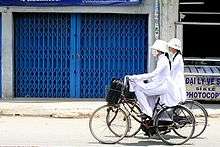
There are also uniforms for Physical Education in Vietnamese schools, this usually includes T-shirt and tracksuit, the T-shirts have school logo on them. The tracksuit jacket is popular and often used as a winter uniform, even outside of gym activity.
There are no specific shoes for Vietnamese students, however, flip-flops, slippers and high heels are forbidden. Sandals and boots are allowed, although students normally wear sneakers or flats to school. Dyed hair, nail polish and make-up are banned in many schools.
Venezuela
School uniforms are used in Venezuela.[88] By Venezuelan decree, uniforms are required at all schools in all grades.[89] Boys wear navy trousers and girls wear navy skirts or trousers, depending on the school. The shirts have short sleeves and the colour varies by the level in which the student is. Students in nursery wear yellow shirts, while students in kindergarten wear red shirts. From first to sixth grade, students wear white polo shirts. From seventh to ninth grade they wear light blue polo shirts, and from tenth to eleventh grade they wear beige polo shirts. These shirts are to be stuffed inside the trousers with a black belt. Black dress shoes are the norm in public school, however some private schools can be more flexible with the shoes to be worn.
References
- see Scott, Jenny (5 September 2014). "The history of school uniforms". BBC News.
- Brunsma, David L. "A Brief History of School Uniforms and Dress Code". The School Uniform Movement and what it Tells Us about American Education. pp. 3 ff.
- McCourt, Laura (4 January 2013). "School Uniform Policy in Scotland, England, Wales and the Republic of Ireland briefing paper 48/13" (PDF). Northern Ireland Assembly. Northern Ireland Assembly Research and Information Service. Retrieved 9 November 2015.
- See e.g. School uniform price list making a distinction between summer uniform and winter uniform.
- Costa, Marina Morena (10 March 2011). "Um em cada quatro alunos de escola estadual recebe uniforme". Último Segundo (in Portuguese). Retrieved 5 January 2020.
- see http://www.huffingtonpost.com/2012/03/23rfid-chip-brazil-student_n_1374886.html
- "Bildungschancen für Straßenkinder in Burundi". Retrieved 18 March 2017.
- "IIEP UNESCO" (PDF). Retrieved 18 March 2017.
- "SCHOOL UNIFORM AND LITTLE SUN". Retrieved 18 March 2017.
- "- The Cambodia Charitable Trust". 13 August 2012. Retrieved 18 March 2017.
- "Owen Sound Sun Times".
- "Dress Code in TCDSB Schools". TCDSB. Retrieved 30 March 2015.
- "Darcos ressort l'uniforme du placard". Retrieved 18 March 2017.
- M. Freyer. "Geschichte der Schulkleidung". In H. Liedtke (ed.). Handbuch der Geschichte des Bayerischen Bildungswesens. 4. pp. 273 ff.
- "BBC NEWS - Europe - School uniform row grips Germany". 9 May 2006. Retrieved 18 March 2017.
- (www.dw.com), Deutsche Welle. "In Germany, Veiled Students Stir Up Uniform Debate - Germany - DW.COM - 08.05.2006". Retrieved 18 March 2017.
- "Worksheets: My school is linked with Africa". CBBC Newsround. BBC. 19 July 2005.
- Agebewode, Samuel (18 December 2010). "North Tongu District Distributes Free School Uniforms, Exercise Books to 40 Schools". The Ghanaian Chronicle. Accra.
- "Nicholas's Story". NewsHour. PBS. 2001.
- "GES introduces new school uniform for JHS students". Graphic Online. 11 April 2019. Archived from the original on 11 April 2019. Retrieved 9 June 2020.
- "Here's the new school uniform for JHS students effective next academic year". 11 April 2019. Archived from the original on 12 April 2019. Retrieved 9 June 2020.
- "Wearing a bit of history". South China Morning Post. 29 November 2011. Retrieved 10 December 2018.
- Lam, Sophia (16 March 2018). "A tale of two cities in uniforms: the story behind green school ties, tartan skirts and blue cheongsams". South China Morning Post. Retrieved 10 December 2018.
- Wordie, Jason (5 May 2017). "Hong Kong's school-uniform culture: a history of conformity". South China Morning Post. Retrieved 10 December 2018.
- "Republic of Indonesia Ministry of Education: School Uniforms". Retrieved 18 March 2017.
- "Israel QA File news, Israel diplomatic map". Archived from the original on 3 April 2009.
- Dr. Zvi Zameret, Fifty Years of Education in the State of Israel, Israeli Ministry of Foreign Affairs, 14 July 1998.
- "la scuola dei grandi" Archived 2011-07-16 at the Wayback Machine.
- "WWF: attenti ai tessuti di grembiuli e abitini per bambini" Archived 2006-08-21 at the Wayback Machine, VITA magazine, 13 September 2004.
- "Students Protest as Italian Senate Passes Reforms". ABC News. New York. Associated Press. 29 October 2008.
- "制服でたどる百年". Retrieved 18 March 2017.
- Uranaka, Taiga (12 November 2003). "Man who gave us loose white socks eyes comeback". Japan Times Online. Retrieved 18 March 2017.
- "Japan's schoolgirls set the trend". 23 November 1997. Retrieved 18 March 2017.
- The Global Fund, PROPOSAL FORM – ROUND 9
- "Goal 2: Achieve Universal Primary Education" (PDF). Retrieved 18 March 2017.
- Kementerian Pendidikan Malaysia 1997. Surat Pekeliling lkhtisas Bil. 3/1983 - Pakaian Seragam Murid-murid Sekolah. Retrieved 4 June 2007. Available online at http://www.pibg.net.my/pekeliling.e.php
- SMK Perempuan Sandakan. Peraturan Sekolah''. Retrieved 5 June 2007.
- Aliran Pemikiran Pendidik Malaysia. Peraturan Sekolah''. Retrieved 5 June 2007.
- Tan Ee Loo, "Teachers and students scoff at 'baseless' statement" Archived 2008-10-07 at the Wayback Machine, The Star, Kuala Lumpur, 23 May 2008.
- Tan Ee Loo, "Student with 'too transparent' uniform can be told to wear undergarment" Archived 2008-06-01 at the Wayback Machine, The Star, Kuala Lumpur, 24 May 2008
- Kementerian Pendidikan Malaysia 1997. Surat Pekeliling lkhtisas Bil. 2/1976 - Potongan Rambut Murid-murid''. Retrieved 5 June 2007.
- "Students get a trimming from their peers", The Star, Kuala Lumpur, 12 August 1998.
- Kementerian Pendidikan Malaysia 2003. Surat Pekeliling Iktisas Bil:7/2003 - Kuasa Guru Merotan Murid Archived 2007-10-13 at the Wayback Machine. Retrieved 4 June 2007.
- https://lopezdoriga.com/vida-y-estilo/por-que-se-usan-uniformes-en-la-escuela/
- https://cnnespanol.cnn.com/2019/06/04/polemica-en-la-ciudad-de-mexico-por-norma-que-permite-a-los-ninos-de-colegio-elegir-entre-vestir-falta-o-pantalon/
- Elaine Webster, "New Zealand School Uniforms in the Era of Democracy: 1965 to 1975" Archived 2012-10-24 at the Wayback Machine in Costume, Volume 42, Number 1, 2008 , pp. 169-183 (15).
- Pictured at The History of School Uniforms.
- See e.g. Uniform rules Archived 2009-05-29 at the Wayback Machine at Logan Park High School.
- Dunbar, Jane (24 November 2011). "Are school uniforms too short?". Stuff.co.nz. Retrieved 15 June 2013.
- The Telegraph, Archived 16 January 2020 at the Wayback Machine
- http://www.deped.gov.ph/index.php/issuances/deped-orders/2008/document/dos200846pdf?limit=20&format=raw&start=20
- "DepEd: No more uniforms for public school students". Archived from the original on 4 April 2015. Retrieved 19 September 2014.
- "Department issues guidelines on wearing of uniforms for exams". The Irish Times. Retrieved 24 September 2017.
- http://one-europe.info/school-uniform-the-russian-experience
- "Mandatory school uniform stages comeback in Russia". Retrieved 18 March 2017.
- "A parent's guide to schooling", SouthAfrica.info.
- Picture of senior high school boys in blazers, short trousers and straw boaters.
- Saksith Saiyasombut & Siam Voices (13 January 2013). "Thailand: What has hair got to do with children's rights?". Retrieved 7 February 2013.
- หนึ่งลมหายใจ (November 2007). เผด็จการเนียน ๆ ในโรงเรียน (in Thai). Retrieved 7 February 2013.
- "School Uniforms in Turkey". K12 Academics. Retrieved 24 February 2019.
- "Obligatory School Uniforms Abolished amid Criticisms". Hürriyet Daily News. 28 November 2012.
- McCourt, Laura (4 January 2013). "School Uniform Policy in Scotland, England, Wales and the Republic of Ireland briefing paper 48/13" (PDF). Northern Ireland Assembly. Northern Ireland Assembly Research and Information Service. Retrieved 9 November 2015.
- "The schools provisions of the Act". Equality and Human Rights Commission. EHRC. 21 May 2014. Retrieved 9 November 2015.
- "School uniform: Guidance for governing bodies, school leaders, school staff and local authorities" (PDF). education.gov.uk. Department for Education. September 2013.
- "School uniform", CBBC Newsround, retrieved on 28 August 2008.
- Bell, Bircham Dyson (5 July 2012). "School uniform policies and the Equality Act 2010". Lexology. Globe Business Publishing. Retrieved 9 November 2015.
- Northen, Stephanie (18 January 2011). "School uniform does not improve results – discuss" – via www.theguardian.com.
- "The History of School Uniforms". Historical Boys Clothing. Retrieved 28 August 2008.
- "Bluecoat Schools". Boys School Uniform. Archived from the original on 8 July 2007. Retrieved 28 August 2008.
- I"Victorian Girls' School Uniform". Object lessons. Archived from the original on 27 April 2006. Retrieved 28 August 2008.
- "School uniforms in the UK". Album 1900. Archived from the original on 21 October 2016. Retrieved 3 September 2016.
- "Authority Strategic Statement of Inverclyde Education Service". Gourock High School. Archived from the original on 14 March 2010. Retrieved 28 September 2009.
- "Problems at School". Adviceguide. Citizen Advice. Retrieved 14 April 2010.
- Guidance to Governing Bodies on Uniform and Appearance Policies. Welsh Government. 25 February 2008.
- "Ruane welcomes new uniforms for the new school term" (Press release). Northern Ireland Executive. 15 September 2009.
- "Public School Uniform Statistics - Education Bug". Retrieved 18 March 2017.
- "Dress for Success: Public School Uniforms". The New York Times. 25 September 1997.
- http://nces.ed.gov/programs/crimeindicators/crimeindicators2011/tables/table_20_1.asp
- "naesp.com - This website is for sale! - naesp Resources and Information". ww1.naesp.com.
- Public School Uniform Statistics. Retrieved on 21 December 2011.
- NCST Fast Facts - School Uniforms. Retrieved on 21 December 2011.
- Viren, Sarah. "Demographics may dictate uniformity." Houston Chronicle. 3 September 2007. A1. Retrieved 13 May 2010.
- Alleyne et al. 418
- Alleyne et al. 418-419
- Alleyne et al. 419
- Volante supletorio reglamento general de estudiantes del sistema de educación pública de Puerto Rico que deroga el reglamento número 5364 de 17 de enero de 1996 (PDF) (in Spanish), Puerto Rico Department of Education, archived from the original (PDF) on 2 September 2009
- Examples of different school uniforms in Vietnam http://www.asiafinest.com/forum/index.php?showtopic=305508&st=0
- "Venezuela - Researching Virtual Initiatives in Education". Retrieved 18 March 2017.
- "Venezuela - Post Report - e Diplomat". Retrieved 18 March 2017.
Bibliography
- Alleyne, Sylvan I., Velma LaPoint, Jennifer Lee and Harold W. Mitchell. "Black Educators' Views on Middle School Students' Dress and Uniforms: Addressing Challenges from Commercialism." The Journal of Negro Education. Vol. 72, No. 4, Commercialism in the Lives of Children and Youth of Color: Education and Other Socialization Contexts (Autumn, 2003), pp. 418–426. Available at JSTOR, Available at Questia, Available at EBSCOHost.
"Fast Facts." U.S. Department of Education. 2014. Web. 12 Nov. 2014. < The NCES Fast Facts Tool provides quick answers to many education questions (National Center for Education Statistics)> Flam, Lisa. Today.com. 19 Aug. 2013. Web. 12 Nov. 2014. < 6C10945768 Are school uniforms helping or hindering?>
| Wikimedia Commons has media related to School uniforms by country. |
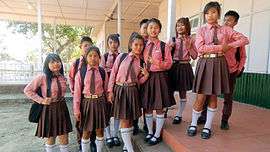
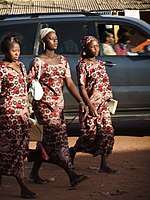
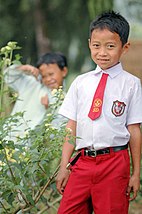
.jpg)
.jpg)